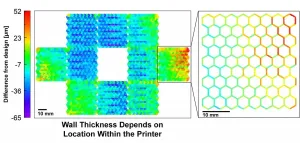PPE supplied to the NHS during COVID-19 pandemic poses challenge to the environment
But there are opportunities for mitigation
2021-03-17
(Press-News.org) According to a new study published in the Journal of the Royal Society of Medicine, the carbon footprint of personal protective equipment (PPE) provided to health and social care staff in England during the first six months of the COVID-19 pandemic was equivalent to flying from London to New York 244 times every day. The good news is that adopting a range of strategies including increased UK manufacture, reusing and recycling could reduce the environmental impact of PPE dramatically while maintaining the safety of staff and patients.
The study, by Brighton and Sussex Medical School and Brighton and Sussex University Hospitals NHS Trust, found that the 3 billion items of PPE used from February to July last year generated 591 tonnes of carbon dioxide a day, or 27,000 times the average individual's carbon footprint. The 1.8 billion gloves used had the biggest environmental impact, followed by aprons, face shields and masks.
The study also suggested ways in which PPE use in the future could lessen environmental impact. This includes reusing gowns and face shields where possible, recycling PPE waste, and manufacture of PPE in the UK. But the biggest impact could be through reducing the volumes of PPE used, for example using hand-washing instead of wearing gloves.
Chantelle Rizan, a doctor in the NHS and a research fellow at the Royal College of Surgeons of England, led the study. She said: "COVID-19 has impacted many aspects of life. Ours is the first study to look at the environmental harm of using PPE on such scale, and the results are concerning. However, a combination of strategies could have reduced the carbon footprint by 75%. We are not advocating actions that could increase risk of infection, however, guidelines around use of PPE aren't always consistent or up to date with the latest science. It may be perfectly safe to wash hands rather than use gloves in many situations, and that is something that needs further exploration."
Professor Neil Mortensen, President of the Royal College of Surgeons of England, said: "It's clear the virus will be with us for some time yet, so the need for PPE to keep staff and patients safe is still paramount. But the findings of this new study are sobering, and we must also consider how to reduce the environmental impact of PPE, including making greater use of reusable items or how PPE and other plastic healthcare waste can be recycled - something the College's Sustainability in Surgery working group is looking at."
INFORMATION:
The study has been published in the Journal of the Royal Society of Medicine and can be accessed at:
https://journals.sagepub.com/doi/full/10.1177/01410768211001583
ELSE PRESS RELEASES FROM THIS DATE:
2021-03-17
Precision or invar alloys have been developed by scientists for many centuries. These iron and nickel-based alloys are capable of keeping their size unchanged within a given range of temperatures. Because of this, they are used in the manufacture of precision gages, standards of length, details for mechanical dial plates, and similar devices. However, invar alloys lack many other useful physical characteristics, and this limits their use in other areas, for example, those that require high thermal conductivity of materials. Therefore, scientists have long been trying to create a unique composite material based on other metals ...
2021-03-17
Connections are crucial. Bacteria may be most dangerous when they connect - banding together to build fortress-like structures known as biofilms that afford them resistance to antibiotics. But a biomolecular scientist in Israel and a microbiologist in California have forged their own connections that could lead to new protocols for laying siege to biofilm-protected colonies. Their research was published in the Proceedings of the National Academy of Sciences (PNAS), USA.
This interdisciplinary collaboration began with a lecture given at the Weizmann Institute of Science in the Life Sciences Colloquium. Prof. Dianne Newman of the California Institute of Technology was the speaker, ...
2021-03-17
A research breakthrough shows that a simple blood test could reduce, or in some cases replace, the need for intrusive surgery when determining the best course of treatment for patients with a specific type of brain tumour.
Researchers at the Brain Tumour Research Centre of Excellence at the University of Plymouth have discovered a biomarker which helps to distinguish whether meningioma - the most common form of adult primary brain tumour - is grade I or grade II.
The grading is significant because lower grade tumours can sometimes remain dormant for long periods, not requiring high risk surgery or harsh treatments such as radiotherapy and chemotherapy. Tumours classified as grade II can progress to become cancerous and more aggressive treatment may be needed in order ...
2021-03-17
Many athletes, from football players to equestrians, rely on helmets to protect their heads from impacts or falls. However, a loose or improperly fitted helmet could leave them vulnerable to traumatic brain injuries (TBIs), a leading cause of death or disability in the U.S. Now, researchers reporting in ACS Sensors have developed a highly sensitive pressure sensor cap that, when worn under a helmet, could help reveal whether the headgear is a perfect fit.
According to the U.S. Centers for Disease Control and Prevention, 1.6 to 3.8 million sports- and recreation-related TBIs occur each year in the U.S. Field data suggest that loose or improperly fitted helmets can contribute ...
2021-03-17
March 17, 2021-- A new study published online in the Annals of the American Thoracic Society reveals how socioeconomic factors partially explain the increased odds that Black and Hispanic Americans have of testing positive for SARS-CoV-2, the virus that causes COVID-19.
In "Association of Race and Ethnicity With COVID-19 Test Positivity and Hospitalization Is Mediated by Socioeconomic Factors," Hayley B. Gershengorn, MD, associate professor, Division of Pulmonary, Critical Care and Sleep Medicine, University of Miami Miller School of Medicine and co-authors ...
2021-03-17
Scientists at Sanford Burnham Prebys Medical Discovery Institute demonstrated for the first time that blocking "cell drinking," or macropinocytosis, in the thick tissue surrounding a pancreatic tumor slowed tumor growth--providing more evidence that macropinocytosis is a driver of pancreatic cancer growth and is an important therapeutic target. The study was published in Cancer Discovery, a journal of the American Association for Cancer Research.
"Now that we know that macropinocytosis is 'revved up' in both pancreatic cancer cells and the surrounding fibrotic tissue, blocking the process might provide a 'double whammy' to pancreatic tumors," ...
2021-03-17
Researchers at University of Illinois Urbana-Champaign developed software to improve the accuracy of 3D-printed parts, seeking to reduce costs and waste for companies using additive manufacturing to mass produce parts in factories.
"Additive manufacturing is incredibly exciting and offers tremendous benefits, but consistency and accuracy on mass-produced 3D-printed parts can be an issue. As with any production technology, parts built should be as close to identical as possible, whether it is 10 parts or 10 million," said Professor Bill King, Andersen Chair in the Department of Mechanical Science and Engineering and leader of the project.
The team's ...
2021-03-17
- The increasing complexity of treatments for lung cancer and language differences can make it difficult for patients to communicate with their medical teams
- Risks of jeopardising the treatment and care journey as well as recent progress in patient empowerment.
Lugano, Switzerland; Denver, CO, USA, 17 March 2021 - More than one in 10 patients with lung cancer do not know what type of tumour they have, according to data from a 17-country study carried out by the Global Lung Cancer Coalition (GLCC) to be presented at the European Lung Cancer Conference (ELCC) ...
2021-03-17
What would a volcano - and its lava flows - look like on a planetary body made primarily of metal? A pilot study from North Carolina State University offers insights into ferrovolcanism that could help scientists interpret landscape features on other worlds.
Volcanoes form when magma, which consists of the partially molten solids beneath a planet's surface, erupts. On Earth, that magma is mostly molten rock, composed largely of silica. But not every planetary body is made of rock - some can be primarily icy or even metallic.
"Cryovolcanism is volcanic activity on icy worlds, and we've seen it happen on Saturn's moon Enceladus," says Arianna Soldati, assistant professor of marine, earth and atmospheric sciences at NC State and lead author of a paper describing the ...
2021-03-17
TORONTO, ON - American adults 65 years old and older have better vision than that age group did nearly a decade ago, according to a recent study published in the journal Ophthalmic Epidemiology.
In 2008, 8.3% of those aged 65 and older in the US reported serious vision impairment. In 2017 that number decreased to 6.6% for the 65-plus cohort. Put another way: if vision impairment rates had remained at 2008 levels, an additional 848,000 older Americans would have suffered serious vision impairment in 2017.
"The implications of a reduction in vision impairment are significant," ...
LAST 30 PRESS RELEASES:
[Press-News.org] PPE supplied to the NHS during COVID-19 pandemic poses challenge to the environment
But there are opportunities for mitigation






